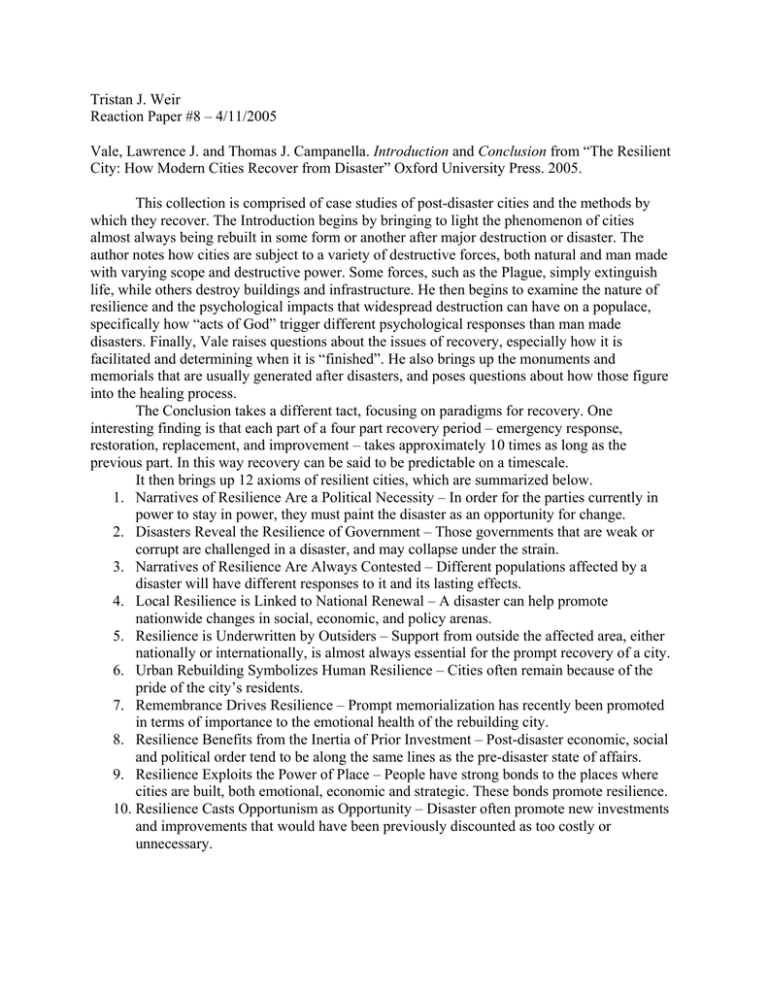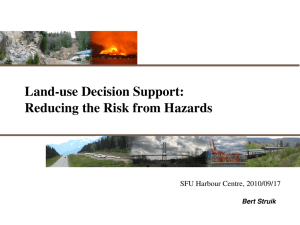Tristan J. Weir Reaction Paper #8 – 4/11/2005 Introduction
advertisement

Tristan J. Weir Reaction Paper #8 – 4/11/2005 Vale, Lawrence J. and Thomas J. Campanella. Introduction and Conclusion from “The Resilient City: How Modern Cities Recover from Disaster” Oxford University Press. 2005. This collection is comprised of case studies of post-disaster cities and the methods by which they recover. The Introduction begins by bringing to light the phenomenon of cities almost always being rebuilt in some form or another after major destruction or disaster. The author notes how cities are subject to a variety of destructive forces, both natural and man made with varying scope and destructive power. Some forces, such as the Plague, simply extinguish life, while others destroy buildings and infrastructure. He then begins to examine the nature of resilience and the psychological impacts that widespread destruction can have on a populace, specifically how “acts of God” trigger different psychological responses than man made disasters. Finally, Vale raises questions about the issues of recovery, especially how it is facilitated and determining when it is “finished”. He also brings up the monuments and memorials that are usually generated after disasters, and poses questions about how those figure into the healing process. The Conclusion takes a different tact, focusing on paradigms for recovery. One interesting finding is that each part of a four part recovery period – emergency response, restoration, replacement, and improvement – takes approximately 10 times as long as the previous part. In this way recovery can be said to be predictable on a timescale. It then brings up 12 axioms of resilient cities, which are summarized below. 1. Narratives of Resilience Are a Political Necessity – In order for the parties currently in power to stay in power, they must paint the disaster as an opportunity for change. 2. Disasters Reveal the Resilience of Government – Those governments that are weak or corrupt are challenged in a disaster, and may collapse under the strain. 3. Narratives of Resilience Are Always Contested – Different populations affected by a disaster will have different responses to it and its lasting effects. 4. Local Resilience is Linked to National Renewal – A disaster can help promote nationwide changes in social, economic, and policy arenas. 5. Resilience is Underwritten by Outsiders – Support from outside the affected area, either nationally or internationally, is almost always essential for the prompt recovery of a city. 6. Urban Rebuilding Symbolizes Human Resilience – Cities often remain because of the pride of the city’s residents. 7. Remembrance Drives Resilience – Prompt memorialization has recently been promoted in terms of importance to the emotional health of the rebuilding city. 8. Resilience Benefits from the Inertia of Prior Investment – Post-disaster economic, social and political order tend to be along the same lines as the pre-disaster state of affairs. 9. Resilience Exploits the Power of Place – People have strong bonds to the places where cities are built, both emotional, economic and strategic. These bonds promote resilience. 10. Resilience Casts Opportunism as Opportunity – Disaster often promote new investments and improvements that would have been previously discounted as too costly or unnecessary. 11. Resilience, Like Disaster, Is Site-Specific – The interconnectedness of cities can have farreaching impact as parts of the city are destroyed, but the preparedness has an impact on the resilience. 12. Resilience Entails More than Rebuilding – Economic and social recovery are just as important as the rebuilding process in revitalizing a city. I enjoyed the conclusion and its axioms of resilience, but I felt that the introduction was largely immaterial. I think it would have been more productive to read one of the interior chapters and examine the case study. I look forward to discussing some of these specific examples with Professor Vale.






